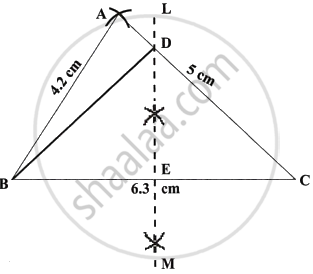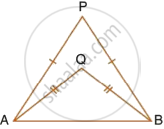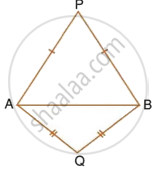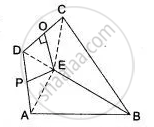Advertisements
Advertisements
प्रश्न
Construct a triangle ABC, in which AB = 4.2 cm, BC = 6.3 cm and AC = 5 cm. Draw perpendicular bisector of BC which meets AC at point D. Prove that D is equidistant from B and C.
उत्तर
Given: In triangle ABC, AB = 4.2 cm, BC = 6.3 cm and AC = 5 cm

Steps of Construction:
- Draw a line segment BC = 6.3 cm
- With centre B and radius 4.2 cm, draw an arc.
- With centre C and radius 5 cm, draw another arc which intersects the first arc at A.
- Join AB and AC. ΔABC is the required triangle.
- Again with centre B and C and radius greater than 12 BC, draw arcs which intersects each other at L and M.
- Join LM intersecting AC at D and BC at E.
- Join DB.
Proof: In ΔDBE and ΔDCE
BE = EC ...(LM is bisector of BC)
∠DEB = ∠DEC ...(Each = 90°)
DE = DE ...(Common)
∴ By side angle side criterion of congruence, we have
ΔDBE ≅ ΔDCE ...(SAS postulate)
The corresponding parts of the congruent triangle are congruent
∴ DB = DC ...(C.P.C.T.)
Hence, D is equidistant from B and C.
APPEARS IN
संबंधित प्रश्न
In each of the given figures; PA = PB and QA = QB.
| i. |  |
| ii. |  |
Prove, in each case, that PQ (produce, if required) is perpendicular bisector of AB. Hence, state the locus of the points equidistant from two given fixed points.
In parallelogram ABCD, side AB is greater than side BC and P is a point in AC such that PB bisects angle B. Prove that P is equidistant from AB and BC.
In triangle LMN, bisectors of interior angles at L and N intersect each other at point A. Prove that:
- Point A is equidistant from all the three sides of the triangle.
- AM bisects angle LMN.
Use ruler and compasses only for this question.
- Construct ΔABC, where AB = 3.5 cm, BC = 6 cm and ∠ABC = 60°.
- Construct the locus of points inside the triangle which are equidistant from BA and BC.
- Construct the locus of points inside the triangle which are equidistant from B and C.
- Mark the point P which is equidistant from AB, BC and also equidistant from B and C. Measure and record the length of PB.
Draw a line AB = 6 cm. Draw the locus of all the points which are equidistant from A and B.
Describe the locus of the moving end of the minute hand of a clock.
By actual drawing obtain the points equidistant from lines m and n; and 6 cm from a point P, where P is 2 cm above m, m is parallel to n and m is 6 cm above n.
In Fig. ABCD is a quadrilateral in which AB = BC. E is the point of intersection of the right bisectors of AD and CD. Prove that BE bisects ∠ABC.
Show that the locus of the centres of all circles passing through two given points A and B, is the perpendicular bisector of the line segment AB.
The bisectors of ∠B and ∠C of a quadrilateral ABCD intersect in P. Show that P is equidistant from the opposite sides AB and CD.
